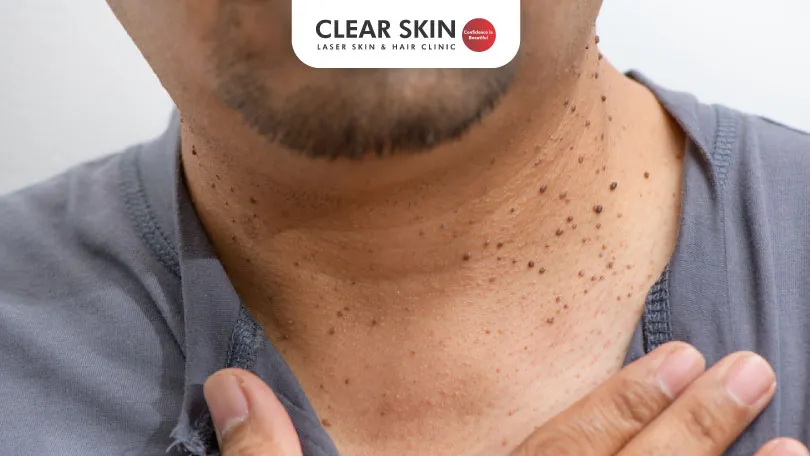Understanding Dermatosis Papulosa Nigra (DPN)
Reviewed By: ![]() Dr. Dhanraj Chavan
Dr. Dhanraj Chavan
Updated on: 30th October, 2021

Dermatosis Papulosa Nigra, commonly known as DPN, is a condition where there are multiple, small, 1–5 mm diameter, smooth, firm, black or dark brown papules on face and neck. DPN is a harmless skin condition and it tends to affect people with darker skin.
DPN is predominantly found in the African population and dark-skinned Asians. This condition is not harmful and one should not be medically concerned with it unless they get itchy or irritating.
DPN are usually smooth black or brown bumps of 1-5 millimetres. It usually starts during adolescence and as you get older, these bumps tend to grow bigger and increase in number.
Table Of Content
- People at Risk
- Causes of DPN Skin
- Symptoms of Dermatosis Papulosa Nigra (DPN)
- Dermatosis Papulosa Nigra Diagnosis
- Dermatosis Papulosa Nigra Treatment
- Conclusion
People at Risk
The African Americans are at high risk to the condition, especially at the age of puberty. There’s a high chance of it being genetically transferred. There are some reports which state that DPN occurs due to a developmental defect of hair follicles.
Causes of DPN Skin
Medical experts are not sure about the exact cause of DPN on face. Although, the darker the skin is, it is more likely for them to develop this condition. It is mostly caused due to genetics but it can also be a byproduct of the natural, unavoidable ageing process.
Symptoms of Dermatosis Papulosa Nigra (DPN)
-
- DPN is mostly characterized by the appearance of small bumps in the facial region with the advance of puberty.
- They range from 1-5 mm in diameter and are black or brown in colour.
- Mostly occurring on the upper part of the cheek, they can take over the entire face as well.
Dermatosis Papulosa Nigra Diagnosis
For a proper diagnosis of DPN, visit a dermatologist. A DPN dermatologist helps in examining the skin and analysing the severity of the issue. Once you visit a doctor, they will look at the skin and examine the typical appearance of the raised spots.
At times a biopsy is done but usually, the distribution pattern of these small black brown dots in the locations mentioned above are sufficient for their identification.
What is DPN And How To Get Rid Of Dermatosis Papulosa Nigra | Clear Skin, Pune
Dermatosis Papulosa Nigra Treatment
DPN is a harmless condition and often does not require any treatment. DPN treatment usually depends on the patient’s compliance. If the spots or bumps get too itchy or you don’t like their appearance and want flawless skin, then there are few ways to treat them. It is always better to minimize the appearance of spots rather than removing them completely.
Some other treatments available for DPN in Indian skin are Surgical removal, Laser treatment, curettage, Freezing with liquid nitrogen (cryotherapy) and Electrodessication. Curettage is scraping off the growth, electrocautery uses the current to cauterize skin tissue and electrodesiccation dehydrates and destroys the superficial tissue – All these methods are said to be the most effective treatment procedures for DPN.
Although cosmetic removal is highly effective, it requires a complete discussion regarding the risks and rewards of opting for the procedure preceding the surgery as it may increase the chances of pigmented scars in the darker skin types.
Following the treatment, one must also take measures to avoid the recurrence of DPN. As UV exposure may play a role in the pathogenesis of DPN, using broad spectrum sunscreen can help prevent the recurrence, keeping your skin healthy.
Do You Know?
Roughly 250 Patients Are Treated
Everyday By These Dermatologists
(You are one click away from flawless skin)
Meet Our Dermatologist!
Conclusion
In conclusion, Dermatosis Papulosa Nigra (DPN) is a common, benign skin condition that primarily affects individuals with darker skin tones. Although it doesn’t require treatment, options like surgical removal, laser treatment, and cryotherapy are available for cosmetic reasons or if the bumps become irritating.
Consulting a dermatologist is crucial for proper diagnosis and tailored treatment. To prevent recurrence, using broad-spectrum sunscreen can be beneficial.
Further Reading
How to Avoid Acne in Monsoons?
Avoid acne in monsoons with a gentle skincare routine, diet tips, and hydration. Get expert advice to manage breakouts and keep your skin clear and healthy.
Does Makeup Cause Acne-Prone Skin?
Worried about breakouts from using makeup? Does makeup cause acne for you? Learn the safe ways to apply makeup for acne-prone skin.
Morning Skin Care Routine for Glowing Skin
Clear Skin Clinic, led by top dermatologists, shares the ideal morning skincare routine to help you achieve a radiant complexion naturally and effectively.
Monsoon Skin Care Tips for Radiant, Healthy Skin
Clear Skin Clinic, led by top dermatologists, shares the ideal morning skincare routine to help you achieve a radiant complexion naturally and effectively.
Have thoughts? Please let us know
We are committed not only to treating you, but also educating you.





